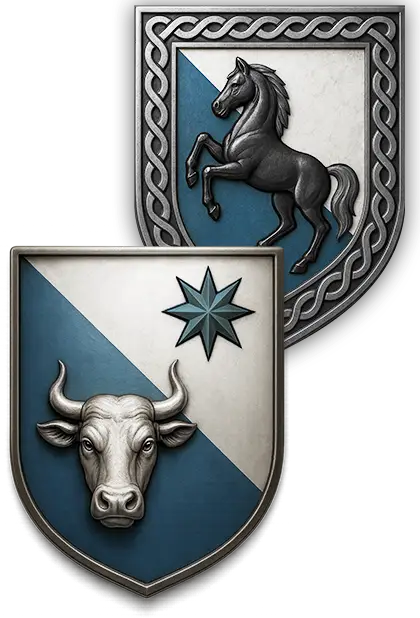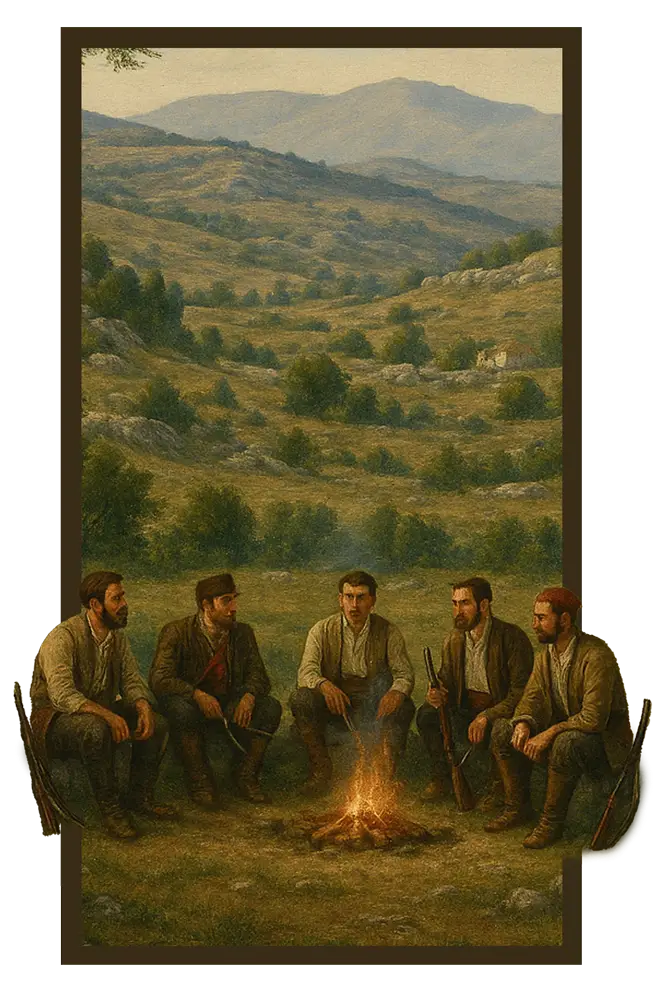From Studenci to Vranjače – and further out into the world
The Trogrlić family
The first traces in the shadow of history (1686–1762)
Origin, meaning and sound of the name
The Trogrlić family’s roots reach deep into the rocky soil of Dalmatia – a land characterized by barren hills, windswept pastures, and the hard-won rhythm of peasant life. The name comes from the phrase “tri grla” – “three throats.” These three throats symbolize what life is all about: one for drinking, one for eating, and one for singing.
It’s an image that captures the joy of life, the will to survive, and the pride of those people who, despite all hardships, never lost their sense of humor or their voice. In the dialect, the name sounds powerful, primal, almost like an echo from a time when names still carried stories – stories of community, pride, and survival.
In old Croatian naming traditions, it was not uncommon to give names based on body parts, abilities, or character traits. According to a regional source, other common surnames also originated from the Trogrlić family, including: Cikoje, Cikojevići, Bubalo, Udiljak, and others.
A study on the history of names in Studenci analyzed over 150 surnames. The name Trogrlić is classified among the medieval Croatian names with a Slavic structure. It probably originated over 500 years ago, possibly from a nickname (e.g., from “grlo” – throat).
According to Anton Željko Lovrić and Valentin Putanec, Trogrlić is a typical example of Old Slavic Croatian surnames that emerged between the late Middle Ages and the early modern period.

Late 17th and early 18th centuries
The first known written mention of the Trogrlić family dates back to 1686, when a family of eight led by Nikola Trogrlić fled Studenci near Imotski, which was then under threat from Ottoman troops, and found refuge in the coastal town of Brela. This escape was part of a larger population movement from the Dalmatian hinterland, triggered by the Ottoman-Venetian Wars.
A significant document is provided by Bishop Nikola Bijanković of Makarska, who, in a 1706 travelogue, mentions that he “arrived in Studenci at two o’clock in the morning and settled down with Petar Trogrlić—in a half-open cattle shed.” This note not only indicates the modest circumstances of the time, but also the early return and resettlement of the Trogrlić family in Studenci. They were once again present, visible—and apparently hospitable.
Another pastoral visit took place in 1710. This time, Bishop Bijanković also mentions the family: two women, Ana Trogrlić and Uršula Marinović, lived in Studenci as Third Order sisters of the Franciscan Order. Their pious life of “fasting and prayer” is explicitly emphasized—a testament to the deep-rooted religiosity within the family.
Family chronicle
- 1686
Eight members of the Nikola Trogrlić family are in exile in Brela, after fleeing from Studenci near Imotski (after the Ottoman defeat).
- 1701
Dujam, Miho and Toma Trogrlić are registered in the Ottoman Register Tapu Dexter No. 861 as permanently present in Studenci and Svilić.
- 1706
Bishop of Makarska Nikola Bijanković stays with Petar Trogrlić in Studenci.
- 1710
Mention of Ana Trogrlić, a Third Order sister (lay order of the Catholic Church).
- 1725
The Republic of Venice grants land to four Trogrlić families in Studenci: Mate, Ivan, Martin and Grgo.
- 1739
In Studenci there are five households under the names: Martin, Ivan, Petar, Augustin and Ilija Trogrlić.
- 1762
Birth of Jure Trogrlić in Studenci.
- 1804
Birth of Ilija “Eljdan” Trogrlić, the first to settle permanently in Vranjače.
Mid-18th century
In 1725, Venetian land registers show that four branches of the Trogrlić family were granted land by the Republic of Venice: Mate, Ivan, Martin, and Grgo.
These figures reflect not only the demographic boom, but also the official recognition by the Venetian administration, which encouraged loyal settlers with such land grants.
The next systematic entry can be found in 1739 in the “Status animarum” (“Status of the Soul”) of the Studenci parish. It lists five Trogrlić households, including their named heads and their family sizes:
- Martin Trogrlić, with 10 members
- Ivan Trogrlić, with 7 members
- Petar Trogrlić, with 7 members
- Augustin Trogrlić, with 7 members
- Ilija Trogrlić, with 12 members
This list confirms the clear division of the Trogrlić family into several branches, some of which later spread to other areas of Duvanjština.
It is particularly noteworthy that the current bearers of the Trogrlić name in Vranjače and Stipanići descend directly from these lines, which originally originated in Studenci. They are living proof of how families branch out over generations, moving on while still maintaining their connection to their roots.
The period between 1739 and 1762 corresponds exactly to the leap between two generations. It is therefore historically highly likely that Jure was the grandson of one of the five men from 1739—only through a son who was not listed by name in the death registers.
- In the source from 1739 we find an Ilija Trogrlić with 12 family members – this is the largest household.
- It is therefore conceivable that Jure (1762) was a grandson or even son of a son of this Ilija.
- The later name of his own son Ilija (Eljdan) could be a deliberate repetition or honor of the original name.


